
Monuments and sculptures honoring Greek Mythology in Australia are all over the place.
It’s great to know there are many impressive statues of the Greek Gods and Goddesses in Australia.
Every state in Australia has sculptures dedicated to Greek mythology themes.
Australia is the world’s largest island continent, the so-called “land down under,” so it’s no wonder the country has plenty of monuments dedicated to the Greek Gods.
I have already mentioned in another post that Australia is the world’s biggest Greek island, so the monuments and sculptures in Australia shown here will help validate that statement.
If you’d like to be in the presence of monuments and sculptures honoring Greek mythology in Australia then here are some of the best things to see.
Sydney Sculptures (New South Wales) – Greek Mythology
Sydney has some of the best monuments dedicated to Greek mythology.
Poseidon (Neptune) – Governor Phillip Fountain
You can find Neptune, God of the sea sculpture, resting at Governor Phillip Fountain in the Royal Botanic Garden in Sydney.

The impressive fountain also has representatives of Commerce (Nymph carrying the staff of Hermes), Agriculture (Goddess Demeter), and Mining (Cyclops – by name only).
Governor Phillip was the first governor of New South Wales from 1788-1792.
Apparently, this was the most expensive sculpture produced in Australia in the 19th century.
The impressive fountain (unveiled in 1897) is situated in the Royal Botanic Gardens, close to Macquarie Street.

Apollo and Diana (Artemis)
Greek Gods and Greek mythology are the themes used to make up
The Archibald Fountain or the J. F. Archibald Memorial Fountain, as it is also known, has statues of Apollo, Artemis, Theseus, and the Minotaur.
You can find the fantastic fountain on the northern side of Hyde Park in central Sydney. It is one of Sydney’s most photographed tourist attractions.

How times change!

It has to be one of the best Greek Mythology Water Fountains in the World.
Theseus and the Minotaur
The Archibald fountain in Australia even pays tribute to the Greek hero Theseus, the slayer of the Minotaur, the monstrous half man, half bull.

At the other end of Hyde Park, you will find the Pool of Reflection, an Anzac War Memorial. Just west of the fountain is a giant chess set.
Hyde Park was the city’s first public space, where Australia’s first recorded cricket matches were played back in 1804.
The Archibald Prize
You may be wondering who or what Archibald is.
Jules Francois Archibald (1856-1919) started the Bulletin magazine in Australia, which is similar to that of America’s Time magazine.
His name is now best associated with Australia’s yearly Archibald Prize for Portraiture, which was first established in 1920.
It is considered to be the most prestigious Australian art prize even to this day.
We can thank J. F. Archibold for bequeathing funds that made building the impressive fountain possible.
In the bequest, he specified that it had to be designed by a French artist, both because of his great love of French culture and to commemorate the association between Australia and France in World War 1.
It was unveiled in Sydney on 14 March 1932.
Here are some more pictures of the Archibald Fountain with Apollo.
Athena Statue – Barrack Street
A large bronze statue of the Greek Goddess Athena stands in Barrack Street in Sesquicentenary Square.

The Mayor of Athens gifted this statue to Australia for the Sydney Olympics in 2000. The Goddess can be sighted outside a classy Greek restaurant called the ‘Athenian’.
The Greek Goddess of Australia

Ada Nicodemou – The Greek Goddess of Australian television, sculptured to perfection.
For those who don’t know, she is the Australian Greek Goddess who starred in The Matrix.
Venus Fountain
Venus – Venus Fountain in the Royal Botanic Gardens
The Venus fountain statue can be found in the Main Pond of the Royal Botanic Gardens.
It was originally erected just before 1880, probably in 1879 for the International Exhibition.
In the picture below, you can just see Venus from the Band Lawn in the Lower Gardens of the Royal Botanic Garden.

The Love Goddess with cupids riding dolphins at her feet was originally surrounded by weathered rocks and large clam shells.
However, for some reason, they were later removed and replaced with a sculptured crocodile. Holy hell!

Over time the statue deteriorated so badly that it needed restoration.
In August 1990 the statue was cast in bronze and in September 1994 it was reinstalled in the pond, but due to the process, the original was lost. The base of the fountain is currently unadorned.
This statue known as ‘Venus arising from the sea’ was greatly admired by a botanist in Adelaide who wanted one for the Adelaide Botanic Garden.
It survived until the early 1970s but somehow Venus ended up disappearing without a trace.
Other Sydney Sculptures based on Greek Mythology
The Satyr – Can be seen in the Royal Botanic Gardens close to the Opera House.

Cupid (Eros) – Can be found in the central pond of the Pioneer Memorial Garden within the Royal Botanic Gardens.
Mercury (Hermes) – The University of Sydney
Venus (Aphrodite) – She did appear at The Art Gallery of NSW (circa. 1927) as part of Australia, the new Greece exhibition.
Satyr – The 1924 bronze sculpture of a Satyr (half human/half goat) is located at the Sydney Royal Botanic Gardens.
Hermes – The Art deco Bas-relief of Hermes is located at 10 Phillip Street, Sydney.
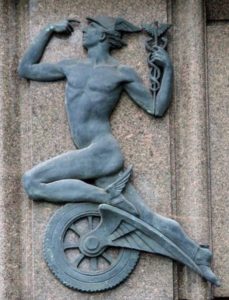
Circe – A bronze sculpture is located at the Art Gallery of NSW.
This work is a statuette version of Bertram Mackennal’s ‘Circe’. It envisions the enchantress at the moment when she transformed the crew of Odysseus into swine.
 Nike – This beautiful sculpture is located at 303 Marrickville Road, outside the Marrickville Town Hall.
Nike – This beautiful sculpture is located at 303 Marrickville Road, outside the Marrickville Town Hall.
The Greek Goddess of victory was unveiled outside the town hall in 1919 before a crowd of approximately 15,000. The sculpture was commissioned to represent a memorial to the 450 residents whose lives were lost in combat during World War 1.
At one stage the sculpture was relocated to the Australian War Memorial in Canberra.
In April 2015 a modern 4-metre (13 ft) bronze statue of Nike was unveiled, with the sword pointing downwards instead of upwards, after Zeus used the previous uplifted sword for lightning-bolt target practice.
Nike – This very unusual 25-tonne painted steel abstract sculpture was created to honor the steel industry. You can find it in Wollongong, however, you won’t know that it’s Nike unless someone tells you.

Neptune – Resting on the roof of Neptune House (The old Fish Market) at 1 The Close, Riverside, Newcastle.
Nike – The Nike (Kougioumtzis) is an abstract sculpture that has been donated to every host city of the Olympics since 1996, so I’m assuming it is hiding somewhere in Sydney.
Atlas – Tebutt Observatory
Atlas has resided at the Tebbutt Observatory in Palmer Street, Windsor, for a long time.
It was named after John Tebbutt (1834-1916), the founder and builder of the Observatory.
He’s well respected for discovering two comets and for taking part in the worldwide observations of the Transit of Venus in 1874.
The Australian astronomer was later honored by the International Astronomical Union in 1973, long after his death, with a Luna crater named “The Tebbutt Crater.”
More famously, his portrait appeared on the back of an Australian $100 banknote from 1984 to 1996.

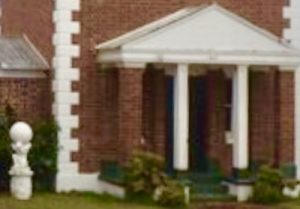
Sir Douglas Mawson, the famous Australian Antarctic explorer appeared on the front of the banknote.
The Atlas statue in the photo on the right was strategically positioned at the front of the Tebbutt’s Observatory, which says a lot.
The Observatory can also be seen on the right side of John Tebbutt’s portrait on the one hundred dollar note.
His picture on the hundred dollar note actually covers up Atlas, which is directly behind him, pretty much straight under where his last name “TEBBUTT” appears in very tiny text.
Does this mean that the Australian Government or those in the know 100% back the Greek Gods?
The Norman Lindsay Gallery
Norman Lindsay Gallery – Located in Faulconbridge, New South Wales, in the famous Blue Mountains district.
Have you ever seen the movie “Sirens” starring Australian supermodel Elle Macpherson? Some of the scenes were filmed here.
The Satyr and Nymph – Norman Lindsay Gallery and Museum
This sculpture known as The Satyr pursuing a Nymph dates back to about 1913. It is located near the gallery entrance doors next to the seahorse fountain.
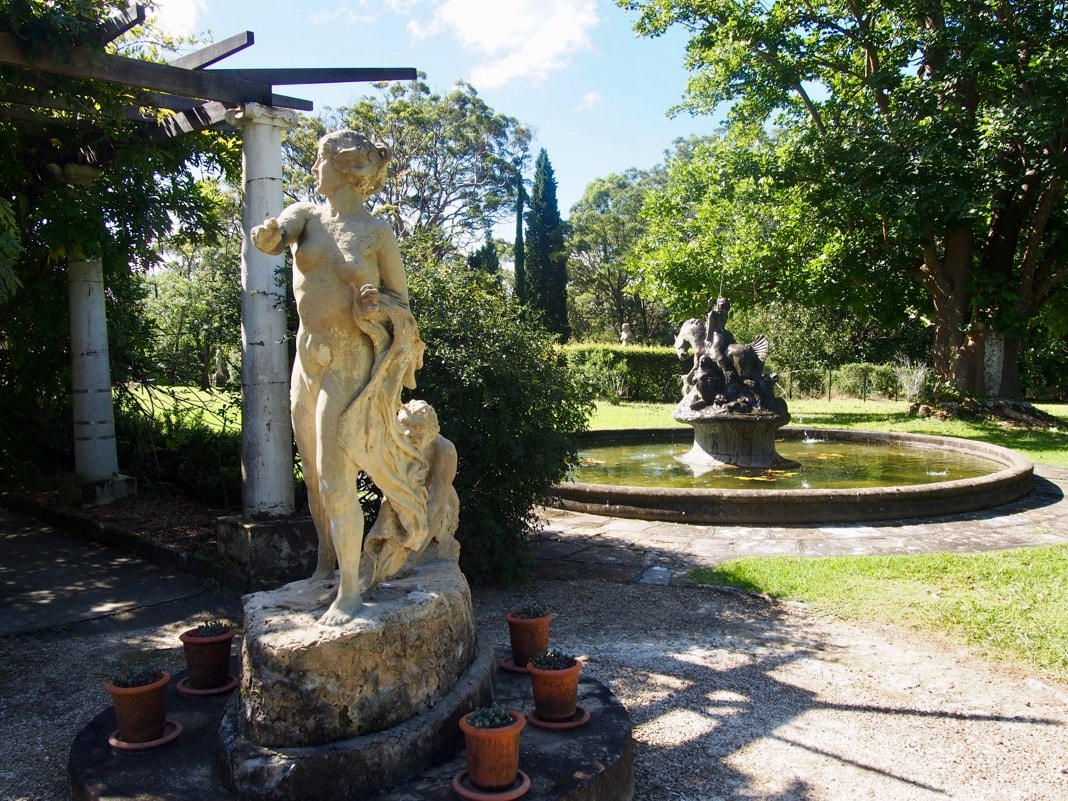
For anyone interested, yes, Greek Gods definitely created beautiful women.
Monument of Lysicrates
This is a replica of the original monument made of marble and erected by Lysicrates on Tripodon Street in Athens in 334BC to commemorate a big win at an annual drama competition at the Dionysia.
You can see the replica monument of Lysicrates in the Sydney Royal Botanical Gardens. The original ancient monument in Athens is seen on the right.

Sir James Martin, three times Premier of New South Wales between 1863-1872 had the replica built for his own garden at Potts Point in 1870.
It was moved to Sydney’s Royal Botanic Garden in 1943 which is relatively close to the Sydney Harbour Bridge as you can see. The monument also underwent restoration around 70 years later.
The frieze on the monument shows the Greek God of wine and theatre, Dionysus, fighting off pirates. The pirates who have angered Dionysus get turned into dolphins when thrown into the water as told in the Greek myth.
You can find the Venus fountain very close by.
Australian Goddess – Jennifer Hawkins
Jennifer Hawkins, Miss Universe 2004
Prepare to be dazzled by the swimsuit Goddess walk.
The video below shows Jennifer being crowned Miss Universe, the Thunder from Down Under.
Zeus, God of Thunder, would definitely approve of the title.
Melbourne Sculptures (Victoria) – Greek Mythology
Mercury (Hermes) – A 4m tall statue of Mercury was positioned at the top of the old Age Newspaper building in Collins Street in 1899.

The current home of Hermes (Mercury) is in The Melbourne Museum.
Chronos – Hangs around at the Royal Arcade in Melbourne, considered to be the first arcade in Australia. Chronos is the God of time in Greek mythology.
Apollo – Sculpture named Apollo. Located at Apollo Bay (Great Ocean Walk).
Apollo Belvedere, Diana bust, Hercules bust – Queen Victoria Gardens
Perseus – Moved to the Botanical Gardens and re-erected at the Robert Clark Centre.
Icarus – First located at Tullamarine Airport in Melbourne.
Icarus eventually moved to Langwarrin Gallery and Sculpture Park, since it is unlikely anyone wanted to be reminded of what happened to Icarus before they boarded a plane flight.
I was lucky enough to see it at the airport and I have to admit it did make me think.
Never regret thy fall – O Icarus of the fearless flight – For the greatest tragedy of them all – Is never to feel the burning light.
~ Oscar Wilde ~

Apollo and Diana (Artemis) – The 2.5 – 3 meter high sculpture of “The Sun and the Moon” is made up of two figures facing each other. This savage-looking surreal sculpture is full of symbols.
There’s Apollo, the sun, Diana, the moon, lightning, and the minotaur. A few feet away from this picture is the moon Goddess.
It can be seen on the corner of High and Glenferrie roads in Malvern, Melbourne.
Perseus, Atlas, Nike – Located on The University of Melbourne grounds. Nike is inside the ceremonial Wilson Hall.
Atlantes – Ended up being re-erected at The University of Melbourne car park entrance in 1972.
Eternity-Buddha in Nirvana – A humungous Buddha sculpture covered predominately in casts of classical Greco-Roman sculptures.
These sculptures include Farnese Hercules, Satyr and Bacchante, Achilles, Dancing Faun, Crouching Aphrodite, Narcissus Lying, Othryades the Spartan Dying, and the Fall of Icarus.

The Chinese artist, Xu Zhen, wanted to bring Eastern and Western cultural heritages together by combining a replica of a famous reclining Buddhist statue with that of predominately Greco-Roman sculptures.
At the end of the 18m long Buddha statue is a statue of Hercules.
Gallery location: Federation Court, Ground Level, NGV International (National Gallery of Victoria), Melbourne
Xu Zhen is also the artist behind the Eternity Poseidon Statue in De Haan, Belgium. It’s a delicious sculpture combining a Greek God with Peking Ducks. It makes me hungry every time I look at it.
Cultural rubble – Venus de Milo, Winged Victory of Samothrace, Discus thrower, and Greek pots are found on the side of a wall at the Ian Potter Museum of Art with fragments that spill out into Swanston Street, University of Melbourne.
You can see the Winged Victory of Samothrace in the feature image at the top.
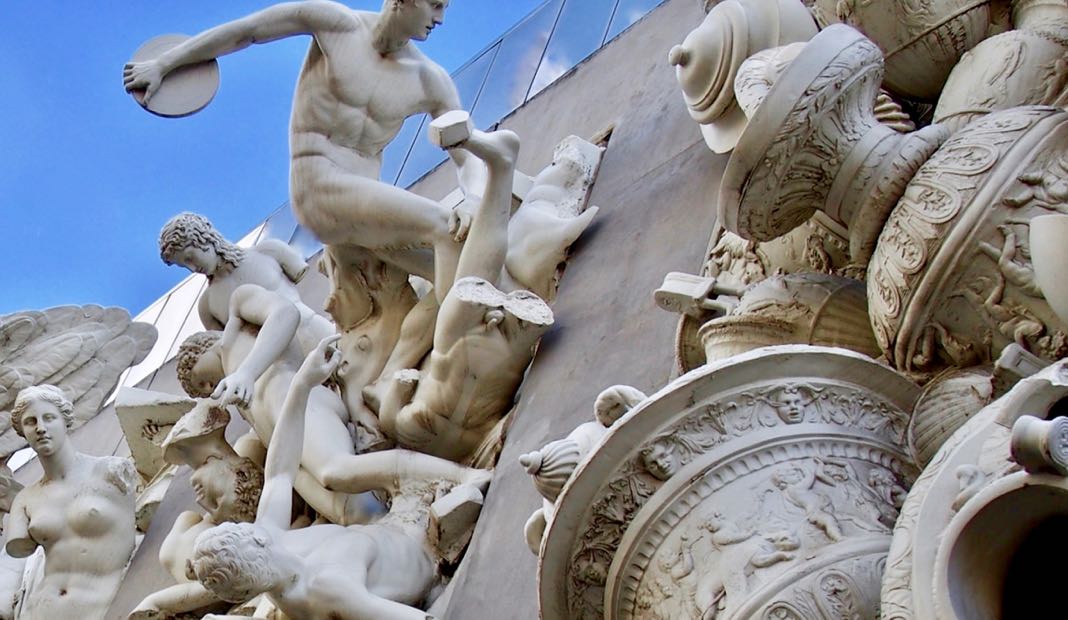
Trial of Socrates – University of Melbourne
Poseidon – Can be found in the courtyard of the Elizabeth Murdoch building at the University of Melbourne.
It’s a copy of the Poseidon of Artemision housed in the National Archeological Museum in Athens. It was a gift for the 1956 Melbourne Olympic Games.
King Leonidas – King of Ancient Sparta.

Watch the movie 300 if you don’t know who he is. It’s located at Sparta Place, Brunswick.
This sculpture also has a shield below the plaque.
Atlas – Located on a building on Collins Street, close to Queens Street. Used to be perched on top of the Atlas Insurance Building at 406 Collins Street.
Hebe – Hebe was the Goddess of eternal youth. She’s the daughter of Zeus and Hera, who married Heracles. You can see her in Fitzroy Gardens.
Hercules, Leda, Mercury (Hermes), Hebe – Located at the Ballarat Botanical Gardens (one hour drive outside of Melbourne).
Shrine of Remembrance Monument – Victoria’s National War Memorial
The Shrine of Remembrance was built using a classical style based on the Tomb of Mausolus at Halicarnassus and the Parthenon in Athens.
The impressive monument was originally built to honor the men and women of Victoria who served in World War I. It is now used as a place of reflection for all armed conflicts.

The Shrine officially opened with a dedication ceremony in 1934. Over 300,000 people attended the ceremony, which was an enormous crowd considering Melbourne’s population at the time was approximately 1 million.

Greek Gods – Visit the Hellenic Museum in Melbourne to see if anyone is there.
Brisbane Sculptures (Queensland) – Greek Mythology
Themis – Themis was the daughter of Uranus (Sky) and Gaia (Earth).
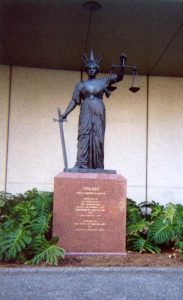
Historically she’s a Goddess of order and assemblies, which is a great reason for her to be part of The Law Courts Complex on George Street in Brisbane.
The imposing sculpture of the Greek Goddess of Justice stands outside the Supreme Court in Brisbane on the left side of the courtyard.
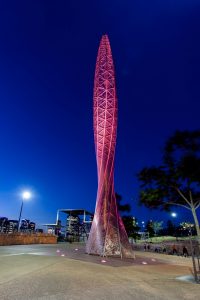
Venus Rising – Kangaroo Point Park, Main Street. It looks like a giant s*x toy for the love Goddess.
Neptune (Poseidon) – Sheraton Mirage Resort & Spa
Hippocrates – University of Queensland Medical School, Herston
Pegasus – Garden courtyard, Meriton Suites, Broadbeach
Neptune (Poseidon) – Can be seen at the Candyman’s luxury home overlooking a Gold Coast canal. You can get a glimpse of Poseidon in this video clip. The notorious tobacco mogul has lived a playboy lifestyle in Australia.
For a better view of Poseidon at the same party watch the video below.
Adelaide Sculptures (South Australia) – Greek Mythology
Amalthea and Jupiter’s (Zeus) goat – A copy of the sculpture by Pierre Julien from 1787, which is in the Louvre Museum.
You can see it in a fabulous location at the Adelaide Botanical Gardens.

Hercules – The bronze Farness Hercules sculpture was unveiled in October 1892 in Victoria Square, which is Adelaide’s prime city square. It’s a copy of the Farnese Hercules excavated in Naples in the sixteenth century.

It was eventually relocated on top of the pedestal in Pennington Gardens, Adelaide, due to a few complaints from 1902 to 1930 regarding the shamefulness of its nakedness.
In 2000 the Lord Mayor of Adelaide wanted Hercules back at Victoria Square, but that never happened.
Hercules made another small move a bit later on in 2015 to accommodate Adelaide Oval redevelopments.
It is now at the intersection of footpaths in a landscaped garden within Pennington Gardens close to the eastern side of Adelaide Oval.
Venus (Aphrodite) – Can be found in a prime position on North Terrace right in front of Government House. You can see a top portion of Government House behind the wall.

Venus has the honor of being Adelaide’s very first public street statue unveiled in 1892.
Neptune (Poseidon) – A large king Neptune statue once stood next to the Neptune Service Station at Darlington on South Road. Last seen in the area in 1989.

Poseidon moved around a bit and then appeared in a garden at Viva Energy’s Birkenhead Bitumen Centre on Wills Street in Birkenhead.
No one knows where Poseidon could end up next. This proves that the Greek Gods are rock solid.
Anteros – This is a cast of the famous Anteros figure which can be seen at the center of London’s Piccadilly Circus.

The Art Gallery of South Australia owns it and at one time Anteros was located in a prime position in the Elder Wing.

Only a handful of Anteros castings were ever made in the entire world. How this rare Anteros ended up in Adelaide is anyone’s guess.
If you don’t know who Anteros is (no he isn’t Eros), you can find out a little bit about him in another post: EROS: Greek God of Love (Roman name: CUPID).
Pan fountain – You can find Pan playing his Pan pipes while water is flowing through the musical instrument at this special fountain in Veale Gardens, next to Adelaide’s South Terrace.
A beautiful time to visit is when the flowers are in full bloom.

Perth Sculptures (Western Australia) – Greek Mythology
King Neptune statue of Two Rocks
Neptune (Poseidon) – The ginormous King Neptune statue can be found at the old Atlantis Water Park in Two Rocks.
The giant sculpture of Neptune was built in 1981, but the park closed in 1990 due to financial difficulties.
The abandoned Atlantis Marine Park is located 60 km (37 miles) north of Perth.
It was part of Alan Bond’s Yanchep Sun City plan. The limestone statue of King Neptune holding onto his trident has since become heritage-listed.
Neptune has been covered in graffiti over the years.
In 2015, the giant Neptune was restored to its former glory even though it still looks to be residing in a wasteland.
Interesting Fact: Alan Bond’s Australia II syndicate won the 1983 America’s Cup in what was the first winning challenge to the New York Yacht Club.
The Americans had successfully defended the cup for 132 years until the Australians defeated them.
You obviously have to thank Neptune for that sort of feat.
Atlas – At one stage Atlas was located on the roof of the Atlas Building, as you can see below.

Made of terracotta, Atlas held up a giant globe made of steel. Atlas then moved inside the Museum of Perth, Atlas Building.
Themis – The Goddess of Justice from the ancient Greek world can be found outside the Police Barracks in James Street, Perth. The barracks have since been associated with Western Australia’s Art Gallery.
Socrates – Situated at The University of Western Australia, Nedlands.
Hobart Sculptures (Tasmania) – Greek Mythology
Venus (Aphrodite) & Diana (Artemis) – Both Venus and Diana overlook everyone as they are standing high on a building ledge in George Street, Launceston.
Launceston is the second biggest city in Tasmania after Hobart.
Neptune (Poseidon) – Guards the Mersey River in Davenport by standing on a very high tripod-like structure.

Davenport is situated on the northern side of Tasmania, where the ferries come and go from mainland Australia.
On another note:
Amphitrite, the wife of Poseidon commemorates the opening in 1936 of a submarine telephone communication cable from Apollo Bay (on mainland Australia) in Victoria to the Australian island of Tasmania.
At the time it was the longest submarine cable in the world. The honour went to a Greek Goddess, which is good to know.
The 1936 blue version of the Amphitrite stamp went up in price by 50 percent.

More Greek Mythology in Australia
- 12 Best Destinations in Australia with Greek Mythology Names
- Greek Mythology Water Fountains in 15 Countries (including Australia)
Pin it … Share it





